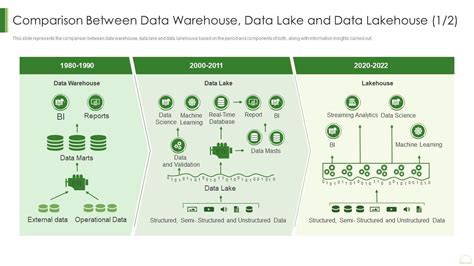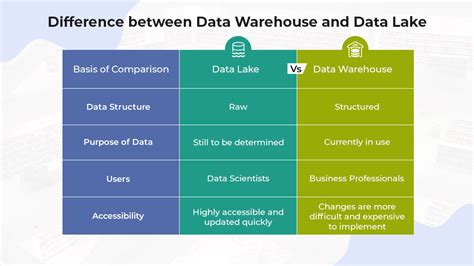The terms "database" and "data lake" are often used in the context of data storage and management, but they represent fundamentally different approaches to handling and utilizing data. A database is a structured repository that stores data in a predefined schema, making it easily accessible and queryable. On the other hand, a data lake is a centralized repository that stores raw, unprocessed data in its native format, allowing for flexible and scalable data analysis.
In recent years, the distinction between databases and data lakes has become increasingly important as organizations seek to leverage their data assets to drive business insights and decision-making. While databases have long been the cornerstone of data management, data lakes have emerged as a complementary approach that offers greater flexibility and scalability. In this article, we will delve into the key differences between databases and data lakes, exploring their architectures, use cases, and benefits.
Key Points
- Databases store structured data in a predefined schema, while data lakes store raw, unprocessed data in its native format.
- Databases are optimized for transactional workloads, while data lakes are designed for analytical workloads.
- Data lakes offer greater flexibility and scalability than databases, but require more complex data processing and analytics.
- Databases are suitable for well-defined, repetitive tasks, while data lakes are ideal for exploratory data analysis and machine learning.
- A combination of databases and data lakes can provide a comprehensive data management strategy.
Databases: Structured Data Management

Databases have been the traditional choice for storing and managing data, particularly for transactional workloads. A database consists of a collection of organized data, typically stored in tables with well-defined schemas. This structured approach allows for efficient data retrieval and manipulation, making databases ideal for applications that require fast data access and updates.
There are several types of databases, including relational databases (e.g., MySQL, PostgreSQL), NoSQL databases (e.g., MongoDB, Cassandra), and graph databases (e.g., Neo4j). Each type of database is optimized for specific use cases, such as transactional processing, document storage, or social network analysis.
Database Architecture
A database typically consists of several components, including:
- Data storage: The physical storage of data, which can be disk-based or in-memory.
- Schema management: The definition and management of the database schema, which includes the structure of tables, indexes, and relationships.
- Query processing: The execution of queries, which involves parsing, optimizing, and executing SQL statements.
- Transaction management: The management of transactions, which ensures data consistency and integrity.
Data Lakes: Unstructured Data Management

A data lake, on the other hand, is a centralized repository that stores raw, unprocessed data in its native format. This approach allows for flexible and scalable data analysis, as data can be stored in various formats, such as CSV, JSON, or Avro. Data lakes are designed for analytical workloads, which involve exploring and analyzing large datasets to gain insights and knowledge.
Data lakes are often built using distributed file systems, such as Hadoop Distributed File System (HDFS) or Amazon S3. These systems provide a scalable and fault-tolerant storage infrastructure, which can handle large volumes of data and support multiple data processing frameworks.
Data Lake Architecture
A data lake typically consists of several components, including:
- Data ingestion: The process of collecting and storing data from various sources, such as logs, sensors, or social media.
- Data storage: The physical storage of data, which can be disk-based or in-memory.
- Data processing: The execution of data processing tasks, such as data cleaning, transformation, and analysis.
- Data analytics: The application of statistical and machine learning techniques to extract insights and knowledge from the data.
| Characteristics | Database | Data Lake |
|---|---|---|
| Data structure | Structured | Unstructured |
| Data schema | Predefined | Flexible |
| Data processing | Transactional | Analytical |
| Scalability | Vertical | Horizontal |
| Data analysis | SQL-based | Machine learning-based |

Comparison of Databases and Data Lakes
When comparing databases and data lakes, several key differences emerge. Databases are optimized for transactional workloads, while data lakes are designed for analytical workloads. Databases require a predefined schema, while data lakes offer flexible and scalable data analysis. While databases are suitable for well-defined, repetitive tasks, data lakes are ideal for exploratory data analysis and machine learning.
Benefits and Limitations
Databases offer several benefits, including efficient data retrieval and manipulation, support for transactions, and robust security features. However, databases can be inflexible and may not support large-scale data analysis. Data lakes, on the other hand, offer flexibility and scalability, support for various data formats, and enable exploratory data analysis and machine learning. However, data lakes can be complex to manage and require significant data processing and analytics expertise.
What is the main difference between a database and a data lake?
+The main difference between a database and a data lake is the structure and purpose of the data storage. A database stores structured data in a predefined schema, while a data lake stores raw, unprocessed data in its native format.
When should I use a database versus a data lake?
+Use a database when you need to store structured data and perform transactional operations, such as in an e-commerce application. Use a data lake when you need to store and analyze large volumes of raw data, such as in a big data analytics project.
Can I use both a database and a data lake in my data management strategy?
+Yes, you can use both a database and a data lake in your data management strategy. In fact, combining the structured data management of databases with the flexible and scalable data analysis of data lakes can provide a comprehensive data management approach.
In conclusion, databases and data lakes represent two different approaches to data management, each with its strengths and weaknesses. By understanding the key differences between these two technologies, organizations can design a comprehensive data management strategy that leverages the benefits of both databases and data lakes. Whether you need to store structured data for transactional operations or analyze large volumes of raw data for insights, a combination of databases and data lakes can help you unlock the full potential of your data assets.



